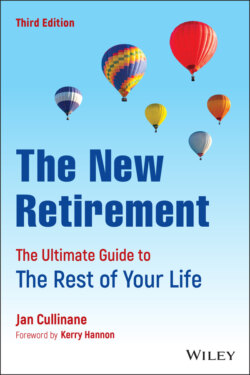Читать книгу The New Retirement - Jan Cullinane - Страница 23
Secret 4: Have a Healthy Body and Mind
Оглавление“Heartache.” “Gut-wrenching.” Money worries that cause headaches. When we think of “mind,” we need to go beyond just the analytical structure of the brain; our mind includes beliefs, attitudes, and emotions. There has been tremendous research demonstrating the powerful effect of the mind-body connection:
One study investigated the link between positive thinking and the risk of frailty. The researchers followed 1,558 older adults for seven years and compared frailty (determined by speed of walking, strength of grip, weight loss and fatigue), with positive thinking by asking participants how many particular positive thoughts they had over the course of the study (such as “I feel hopeful about the future”). As a group, frailty increased among the aging adults, but those with positive emotions and thinking were less likely to become frail.
Another study followed 545 men for 15 years and found that the most optimistic men in the group were half as likely to die from cardiovascular disease as the men who were least optimistic.
Why does optimism work? It's thought that positive emotions may directly influence body chemicals in a way that affects health. And, positive people tend to have increased social interactions (back to Secret 3), which may result in more access to resources.
University of Pennsylvania psychologist Martin Seligman, PhD, has studied happiness and optimism for decades. Seligman suggests we go beyond seeking pleasure and instead look for gratification. What's the difference? Pleasure is not necessarily meaningful and does not always result in a greater good. For example, eating a piece of cheesecake may be pleasurable and feed your stomach, but it doesn't feed your soul. Gratification involves cultivating and nurturing your strengths and putting them to positive use. As an example, Darlene V. and Jonathan tragically lost their first child just prior to childbirth. Although devastated by the loss, they set up a foundation at a local hospital to provide indigent women with the financial resources to bury children who died under similar circumstances. Darlene and Jonathan took their strengths of compassion, generosity, and financial savvy and parlayed them into a gratifying experience in the midst of their sorrow. Likewise, we can cultivate happiness by incorporating strengths such as kindness, humor, optimism and courage into everyday life. Happiness is more of a by-product than a goal.
Martin Seligman coined the term “learned helplessness,” the concept that we internalize that nothing we do matters – that we cannot control our environment, even if we're placed in a new situation. Seligman's findings originally applied to dogs who received unavoidable mild shocks in a lab setting; when the dogs were placed in a new situation, they had “learned” they could not avoid/change their situation, and did not try to do so. Seligman says we can escape this belief that we have no control with “learned optimism.” He suggests “… not to ruminate about bad events that happen to you … I recommend fun distractions, because studies show that if you think about problems in a negative frame of mind, you come up with fewer solutions.” We can train ourselves to think more optimistically and put a stop to distorted ways of thinking. When you think negatively about something, note it, evaluate it, and replace the thought with something more realistic. It takes practice, but it's an effective tool for increasing happiness.
Having a sound body and mind is so important for a successful retirement that Chapter 6 is devoted to this “secret.” I've mentioned the word “healthspan” before, and it's worth repeating that this is the goal: “live long and prosper” – not only financially, but also physically and mentally.
